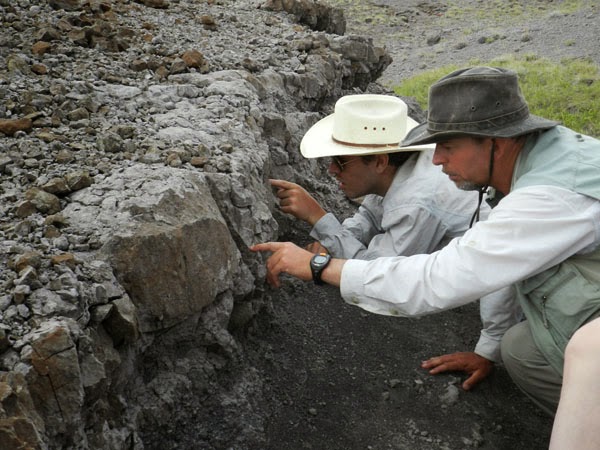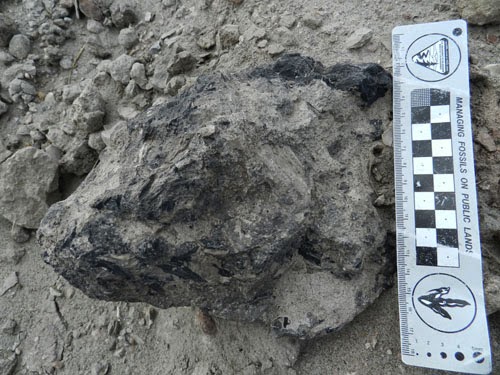 |
| DOORWAY TO THE CRETACEOUS. (photo by Hallelujah Truth) |
 |
| Good-bye to Danielle |
CRETACEOUS STOP #1: COPROLITES
"Get on your 'copro-vision,'" announced my Chiboogamoo as we traipsed across a weathered outcrop in the Two Medicine Formation. We were looking for coprolites - fossilized dinosaur feces - from a species of hadrosaur, Maiasaura, who lived, nested, and yes, pooped at and around this site.
We were not disappointed since this site has been well studied and the presence of these fossilized feces strewn about the landscape by time are well known. Slowly, we began to adjust our "ichno eyes" to spot rocks black in color because of the carbonization of their ancient organic matter. These dino-trace fossils began to pop out from the other rocks. How rewarding!
Maiasaura, a duck-billed dinosaur, had eaten rotten wood. Pieces of this wood was in her feces, which she had eaten perhaps to regurgitate insect-rich food for her young. Named Maiasaura which, from the Greek, means "good mother lizard," her nests were found in the Two Medicine Formation in 1979, and they were the first dinosaurs nests discovered in North America. This discovery rocked the dinosaur world because it suggested that dinosaurs exhibited social behaviors, staying around their nest sites to protect and nurture their young--hence the heart-warming title of "good mother lizard." In other words, Maiasaura did not just lay her eggs and then abandon her young.
 |
| DINOSAUR EGGSHELL FRAGMENTS. (photo by Tony Martin) |
CRETACEOUS STOP #2: PETE'S PUPA PENINSULA
 |
| PETE'S PUPA PENINSULA. (photo by Hallelujah Truth) |
 |
| WASP BEHAVIOR RECORDED IN THE FOSSIL RECORD. (photo by Tony Martin) |
 |
| LOOKING UP CLOSE AT FOSSILIZED PUPA. (photo by Hallelujah Truth) |
CRETACEOUS STOP #3: HADROSAUR FOOTPRINTS ETC....
After reveling in the highest concentration of Cretaceous cocoons in the world at "Pete's Pupa Penisula," our crew headed to the Branvold Bone Bed to see what we might find there and along our journey! We were not disappointed. Our companions, Lee and Ashley had such keen "ichno eyes" and bone recognition, that we lingered in the Cretaceous in the presence of their fossil remains.
Ashley lovingly kept offering fun phrases to express what we were seeing as we stopped at purple dino-bone fragments peering out at us from the brownish grey sand beneath our feet: "explo-o-saurus," "scrap-o-saurus," and "chunk-o-saurus! Thank you Ashley for you fun and abundant imagination!
 |
| SCRAP-O-SAURUS! Lee and Ashley taught my Chiboogamoo and me how to spot bones in the fossil record! Thank you! (photo by Hallelujah Truth) |
What we learn about the past in the present helps us build our understanding of who we are and what came before us!
 |
| WHERE THE HADROSAURS TRAIPSED. MY honey displays what might be a fossilized hadrosaur footprint. (photo by Hallelujah Truth) |
 |
| LOOKING THROUGH A LENS TO SEE THE CRETACEOUS. My darling is examining a fossilized insect burrow. How awesome that this texture has been preserved for millions of years! Photo by Halleluajah Truth |
 |
| CHIBOOGAMOO WITH HIS HALLELUJAH HEADING TO THE CRETACEOUS (photo by Ashley Hall) |
 |
| ATTENDING THE CHURCH OF ICHNOLOGY. Substrate, anatomy, behavior--Amen! Lee and Ashley Hall discussing the Church of Ichnology with my Chiboogamoo. Photo by Hallelujah Truth |
 |
| HALLELUJAH TRUTH IN THE CRETACEOUS. After lunch, our crew went east of Camp Makela to prospect for trace fossils. I took a moment to explore on my own. Photo by Tony Martin |



Your pictures and words tell such a story Ruth!! Thanks for taking us on this journey with you - I am loving it!!!
ReplyDeletePretty nice post. I just stumbled upon your weblog and wanted to say that I have really enjoyed browsing your blog posts. After all I’ll be subscribing to your feed and I hope you write again soon! סדנאות בישול למנהלים
ReplyDelete